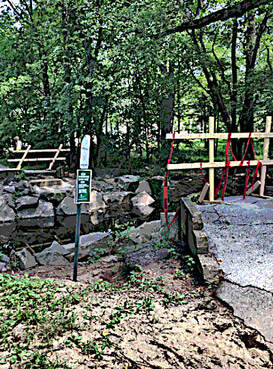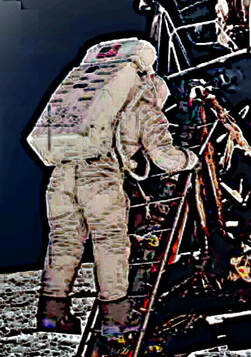
I like to take a walk most every day, an hour at least and usually a bit more. I figure it’s inspirational to the neighbors to see an old codger out strolling the neighborhood. I’ve laid out a few routes so I don’t see the same scenery every time, nor suffer the residents of any particular block too often with my old frame, goofy hat and worn-out sandals. This means that, on occasion, I’ll be walking a particular path that I’ve not been down in a few weeks.
A digression: three weeks ago our neighborhood got a downpour of Biblical proportions. Some 4-plus inches dumped on us in about an hour. There’s a creek I walk along periodically—well, a “run” in Virginia parlance—that I heard on the radio rose 12 feet. Given that there’s usually only several inches of water in this “waterway,” that’s impressive. Still, that was a few weeks back. I decided to walk that route and see whether any damage was still visible.
Well over halfway through the circuit, I hadn’t really encountered anything out of the ordinary. Sure, there had been a tree down along the way, but the county had already chainsawed it into pieces and moved it off the trail. All told the walk was hot but pleasant. I looked forward to the shaded footbridge over Four Mile Run where I often stop for a moment and occasionally see a few ducks splashing in the foot or so of water that pools beneath it.
Not today. The bridge was gone. Apparently that 12-foot surge carried it away. I had to decide. Should I backtrack the half mile to take the bicycle bridge—one thing about Arlington, Virginia; it’s got lots of streams and lots of footbridges—or just wade across? Today Four Mile Run was only a couple of inches deep in places. My sandals and feet would get wet, but it’s 90 degrees, so they’d dry fast.
I remember another creek from years back, Antietam Creek that flows through what is now Antietam National Battlefield. I’ve toured it several times. The last action of the battle took place at Burnside’s Bridge, although it wasn’t called that during the war. General Ambrose Burnside’s Corps was charged with seizing this bridge, which it did, but late enough in the day that Confederate reinforcements from Harper’s Ferry prevented it from turning the Confederate flank. Today, in a memorial on one side of the bridge, are repeated the sarcastic comments of one Henry Kid Douglas, who served with General Stonewall Jackson, to the effect that naming the bridge for Burnside would needs be sarcasm or irony since his forces could have waded the creek in multiple locations. Later scholarship indicates Antietam Creek wasn’t all that easy to cross, by the way. Certainly not while being shot at.
But those words came to me as I considered the less daunting stream in my path. Would I delay my journey merely from a reluctance to get my feet wet? I certainly wasn’t facing enemy snipers on the other bank. Yet defeat or victory were not exactly at stake in my decision. Historians would not debate my course of action. On such a hot day, nary a soul was even around to observe. This was between me and Four Mile Run.
This was not the first time in my life I’ve encountered washed-out bridges or other roadblocks, although more typically metaphorical ones. I’ve even been lost in the woods once or twice, and I’ve faced situations in life where the way forward was unclear. One thing I have learned, though, is that indecision never succeeds. Pick a path and follow it. Better the wrong path than no path at all; you can always adjust later.
I plunged forward, into the three-inch-deep lazy current. The water was cool and felt good on my feet. Climbing up the rocks on the other side, I could feel the soles of my sandals squishing. Fifteen minutes later, feet and footwear were dry. It felt good, knowing I’m not too old to do something usually reserved for the young.
Next time, I’ll take the other path and cross at the bicycle bridge. No reason to be reckless, after all.
David
A digression: three weeks ago our neighborhood got a downpour of Biblical proportions. Some 4-plus inches dumped on us in about an hour. There’s a creek I walk along periodically—well, a “run” in Virginia parlance—that I heard on the radio rose 12 feet. Given that there’s usually only several inches of water in this “waterway,” that’s impressive. Still, that was a few weeks back. I decided to walk that route and see whether any damage was still visible.
Well over halfway through the circuit, I hadn’t really encountered anything out of the ordinary. Sure, there had been a tree down along the way, but the county had already chainsawed it into pieces and moved it off the trail. All told the walk was hot but pleasant. I looked forward to the shaded footbridge over Four Mile Run where I often stop for a moment and occasionally see a few ducks splashing in the foot or so of water that pools beneath it.
Not today. The bridge was gone. Apparently that 12-foot surge carried it away. I had to decide. Should I backtrack the half mile to take the bicycle bridge—one thing about Arlington, Virginia; it’s got lots of streams and lots of footbridges—or just wade across? Today Four Mile Run was only a couple of inches deep in places. My sandals and feet would get wet, but it’s 90 degrees, so they’d dry fast.
I remember another creek from years back, Antietam Creek that flows through what is now Antietam National Battlefield. I’ve toured it several times. The last action of the battle took place at Burnside’s Bridge, although it wasn’t called that during the war. General Ambrose Burnside’s Corps was charged with seizing this bridge, which it did, but late enough in the day that Confederate reinforcements from Harper’s Ferry prevented it from turning the Confederate flank. Today, in a memorial on one side of the bridge, are repeated the sarcastic comments of one Henry Kid Douglas, who served with General Stonewall Jackson, to the effect that naming the bridge for Burnside would needs be sarcasm or irony since his forces could have waded the creek in multiple locations. Later scholarship indicates Antietam Creek wasn’t all that easy to cross, by the way. Certainly not while being shot at.
But those words came to me as I considered the less daunting stream in my path. Would I delay my journey merely from a reluctance to get my feet wet? I certainly wasn’t facing enemy snipers on the other bank. Yet defeat or victory were not exactly at stake in my decision. Historians would not debate my course of action. On such a hot day, nary a soul was even around to observe. This was between me and Four Mile Run.
This was not the first time in my life I’ve encountered washed-out bridges or other roadblocks, although more typically metaphorical ones. I’ve even been lost in the woods once or twice, and I’ve faced situations in life where the way forward was unclear. One thing I have learned, though, is that indecision never succeeds. Pick a path and follow it. Better the wrong path than no path at all; you can always adjust later.
I plunged forward, into the three-inch-deep lazy current. The water was cool and felt good on my feet. Climbing up the rocks on the other side, I could feel the soles of my sandals squishing. Fifteen minutes later, feet and footwear were dry. It felt good, knowing I’m not too old to do something usually reserved for the young.
Next time, I’ll take the other path and cross at the bicycle bridge. No reason to be reckless, after all.
David



 RSS Feed
RSS Feed